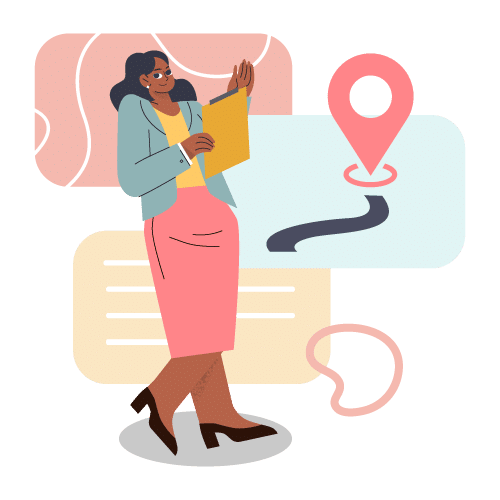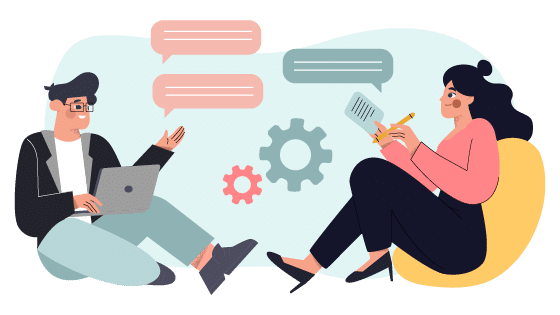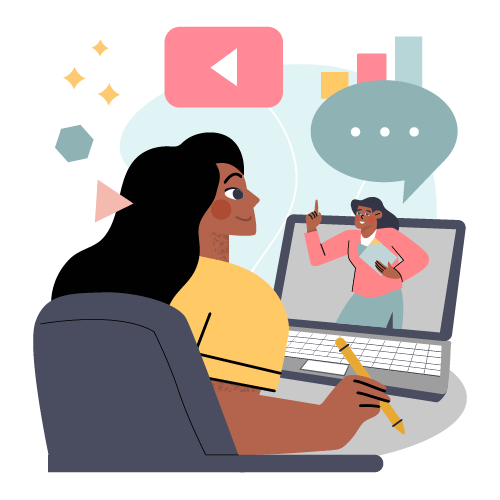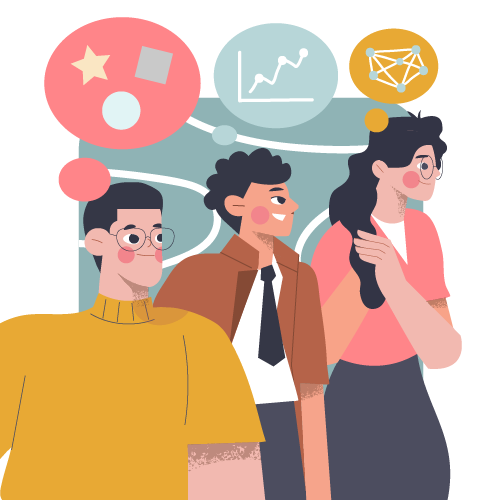The relationship between learning and development (L&D) and human resources (HR) is one that is essential for effectively driving organizational success. This can be achieved in many ways, such as talent development and retention, employee engagement, and performance improvement. HR works closely with L&D to make sure that training and development initiatives are aligned with the overall objectives and strategic goals of the organization. Talent recruitment, onboarding, development, and retention all require a joint effort from HR and L&D to address immediate needs and see to it that all requirements are met.
While both are required to work in tandem in order to contribute to the achievement of company objectives, L&D and HR require separation in the organization. Let’s take a quick dive into L&D and why it’s significant in fostering employee growth and skills enhancement.
Understanding learning and development (L&D)
The term L&D is broadly used to refer to any function that contributes to an organization’s learning and development initiatives. It’s a long-term, ever-evolving process that works to ensure that learners’ skills and knowledge are closely aligned with organizational objectives.
L&D can be mandatory (think required certification) or more casual in nature (an optional online seminar, for example). Any time employees are actively engaged in knowledge transfer, they are participating in L&D. From improved organizational performance to talent retention, the significance of L&D in fostering employee growth and skills enhancement within an organization spans far and wide. When we talk about improved organizational performance, investing in L&D to develop a workforce that strives to continuously learn and grow their skills and knowledge will, in time, increase productivity, drive innovation, enhance performance satisfaction, and achieve sustainable growth and success within the company.
Some might argue that L&D and HR are one and the same but, in reality, there are significant differences in their core responsibilities and priorities and ample reasons to support maintaining distinct L&D and HR functions to foster greater effectiveness in achieving company goals.
L&D vs. HR: 3 key differences
1. Stop “training,” start “learning”
It’s true that there is some responsibility overlap between HR and L&D. But the real difference isn’t the responsibility itself but the approach to fulfilling those responsibilities. HR departments typically follow a by-the-book approach to training: focusing on checklists, compliance, and reactive rules, order, and reporting. While these elements are often vital, they are sometimes seen to only benefit the organization and not the individual learners.
Rather than training employees, L&D professionals seek to foster a culture of learning. They recognize that learning is an integral part of employee growth and that it’s an individual effort that leads to an overall positive company culture.
2. Get personal
Dress codes and corporate conduct? That’s HR’s realm of expertise. It’s HR’s job to set clear expectations, both fundamental and legal, for employees across the organization so there’s no room for interpretation. All of this is necessary, but ultimately unyielding and impersonal.
An L&D focus recognizes that HR functions are vital to the success of a company and its employees but carves a different path for talent management, education, and employee development by honing in on individual skills and unique needs. From compliance training to soft skills, a personal learning environment gives each employee the tools they need to be successful.
3. Value performance over completion
When a new employee starts with an organization, there’s a laundry list of HR functions that need to be taken care of, from explaining vacation policy to discussing office conduct. Once those functions are completed, HR—for the most part—withdraws until their services are needed again.
The best L&D professionals understand that development is an ongoing process and are much more concerned with employee experience than task management. They ask questions about sales numbers, track learning paths, measure customer service satisfaction and job efficiency, and continually develop processes to improve each role. All of this can be tracked with performance measurement tools such as an LMS or informal surveys. With an L&D mindset, growth is the ultimate goal; learning doesn’t stop after onboarding.
The role of HR in enabling L&D
While it’s important to shine a light on the key differences between HR and L&D, the former plays a very crucial role in facilitating L&D within organizations. HR’s involvement in L&D’s initiatives proves to be vital in order to achieve the desired outcome from a business performance standpoint. Building that synergy between the teams requires proactive efforts from both sides, and here’s how HR empowers the learning and development process.
- Managing talent
HR collaborates with various department heads and team leaders to identify skill gaps and training needs within the company, which involves orchestrating regular performance appraisals, employee skill assessments, and analyses of future needs.
Not only that, succession planning is imperative in recognizing potential future leaders and producing development plans for them so that they will be able to take over and ensure businesses continue to run smoothly. This opens up the door to opportunities for internal hiring through reskilling/upskilling.
- Recruiting and onboarding
HR is at the forefront of recruiting prospects who not only possess the skills and capabilities required for the job but also showcase an eagerness to learn and adapt. HR is responsible for curating assessment processes and interview questions to evaluate a candidate’s learning agility and prospect for growth within the organization.
Beyond recruitment, HR designs and implements onboarding programs that kickstart new employees’ journeys into the company, which includes providing the necessary information about available training and development programs right from the start of their employment.
- Implementing L&D initiatives
To design and develop training programs that are tailored to the organization’s needs, HR collaborates with training professionals and experts in the subject matter. Examples of such programs include technical skills training, soft skills workshops, or leadership development programs.
HR also manages the nitty-gritty details of the training programs such as scheduling sessions, booking training venues, ensuring that training materials are on hand, and liaising with outside vendors or trainers if necessary. This allows the L&D department to focus entirely on what’s required of them to deliver the best possible training and development programs for the employees for professional development.
- Creating a conducive environment
The art of fostering a culture of continuous learning in an organization is right down HR’s alley. By communicating and promoting the importance of learning and development to employees, HR places heavy emphasis on personal and professional development alike—the ongoing pursuit of knowledge knows no bounds and can take place in any form.
To add to that, HR ensures that employees are provided access to necessary resources and support systems to partake in L&D initiatives such as learning platforms, allocated budgets for training programs, and mentorship or coaching programs.
Navigating the intersection: Best practices for a collaborative L&D and HR relationship
Both L&D and HR’s core intent is to serve the interesst of employees, and there is a significant overlap between both departments. Now, how can we plan the best possible route to maximize the combined potential of L&D and HR within an organization to improve business performance? Well, glad you asked.
- Establish clear communication channels
This may seem very obvious, but open and transparent communication is imperative for an effective collaboration between L&D and HR. Establishing regular meetings, scheduling email catch-ups, and having a shared communication platform help to facilitate ongoing conversations and allow both departments to share information, cross-analyze wherever necessary, and strategize accordingly to tackle potential gaps within the organization.
- Define roles and responsibilities
To avoid confusion and unnecessary overlap, defining the roles and responsibilities of both L&D and HR departments will establish clear guidelines for who is responsible for what aspects of the development and training initiatives. This includes, but is not limited to, planning, implementation, evaluation, and reporting. Once these roles and responsibilities are laid out and defined, the risk of possible confusion, assumptions, and overlaps lessen substantially between both parties.
- Align L&D with organizational goals
In the process of designing and tailoring L&D initiatives, ensuring that they are closely aligned with the company’s overall strategic objectives and HR’s priorities will prove to be beneficial in the long run to achieve collective goals. Collaborating with HR to identify key business goals and skill requirements will allow for the right kind of training programs to be implemented. Aligning the programs will greatly eliminate unnecessary overlaps and fill any possible gaps.
- Incorporate L&D initiatives in HR practices
In matters such as recruitment, onboarding, performance management, and talent development, HR can integrate learning, career coaching, and development strategies and opportunities to kickstart their employee development plans and career pathways right from the onboarding stage. Why is this crucial? Elevating employee skills and knowledge through L&D and empowering staff will tick all of HR’s boxes which, in turn, will prove highly beneficial in the overall growth of an organization.
The benefits of keeping them separate
As much as it is crucial to have both departments work side-by-side towards collective organizational success, keeping them separate remains the best course of action for companies looking to maximize their advantages.
- Focus on core competencies
When it comes to core competencies, HR should remain focused on subject matters relating to recruitment, employee relations, performance management, compliance and legal knowledge, and talent development. For L&D, more emphasis is placed on matters such as training design and delivery, specialization, learning technologies, assessment, and evaluation. To avoid each team’s focus from getting muddled in the process, separation is key.
- Flexibility and agility
Separating the departments allows for organizations to scale their HR and L&D initiatives according to shifting needs and priorities. Due to the differing roles and priorities, not separating the two teams could allow for potential conflicts of interest to arise between HR’s role in areas like performance management and employee relations versus L&D’s requirements to make decisions in determining training needs or accessing learning outcomes in an impartial way.
- Focus on innovation
L&D teams can focus on innovation and experiment with new learning methodologies, fresh technologies, and creative approaches. This will foster easier adaptation to changing learning trends and requirements. For HR, benefiting from HR-focused innovations will transform traditional HR practices for the better by helping to reshape the way organizations currently manage their workforce and drive success by enhancing efficiency, effectiveness, and employee satisfaction—for example, using eLearning or spearheading programs such as Diversity, Equity, and Inclusion (DEI) initiatives.
- Cultural differences
Separating L&D allows for the design of a distinct learning culture that encourages employees to experiment, take risks, and continue learning for personal and professional development—a far cry from HR’s more traditional, compliance and employee relations-focused culture. While both aim to elevate employee skills and knowledge, L&D initiatives place more emphasis on identifying skill gaps within the workforce and developing targeted programs to address these gaps, whereas HR may place more focus on overall employee management within an organization. - Growth and scalability
As organizations grow, so do the demands for L&D. How can this separation help HR in the long run? Well, it allows for L&D to adopt more scalable and adaptable structures that can grow along with the company’s needs without putting the load on HR. Additional responsibilities beyond HR’s core functions will be met accordingly by learning and development strategies already being put into place.
While collaboration between L&D and HR proves to be essential, keeping separate departments is still equally as important to maximize benefits that contribute to the overall success of an organization. All in all, maintaining distinct L&D and HR functions while fostering specialization, focus, flexibility, innovation, and tailored solutions will allow employees to continuously learn and upskill themselves, enable focused attention on core functions without diversions, and allow for curated solutions to cater to all the needs and challenges within the company.
Transform your team’s learning experience with tailored solutions that bridge the gap between Learning & Development and Human Resources. Let us help you design and develop custom eLearning that fits your unique organizational needs. Ready to elevate your training strategy? Contact us today and discover how our expert solutions can empower your workforce.






